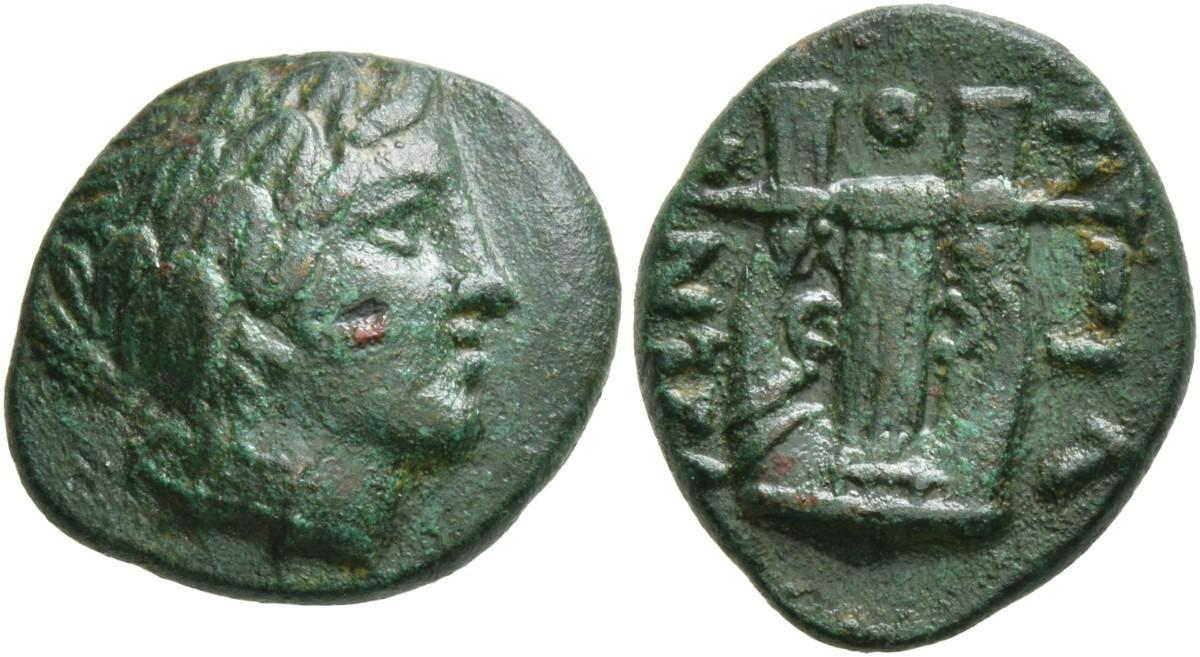AC 153 - Botteatai, bronze (Apollo/cithara) (390-350 BCE)
From SILVER
390 BCE - 350 BCE Bronze
Description
| ObverseInscription or printing placed on the obverse.: | Laurate head of Apollo to right |
| ReverseInscription or printing placed on the reverse.: | ΒΟΤΤΙΑ-ΙΩΝ (Greek).Kithara |
Mint and issuing power
| MintIdentifies the place of manufacture or issue of a numismatic object.: | Botteatai | Ancient regionAncient region.: | Macedon | Modern countryModern country: Greece | AuthorityIdentifies the issuing power. The authority can be "pretended" when the name or the portrait of X is on the coin but he/she was not the issuing power. It can also be "uncertain" when there is no mention of X on the coin but he/she was the issuing power according to the historical sources: | Botteian league |
Chronology
| FromIdentifies the initial date in a range assigned in a numismatic context. | 390 BCE | toIdentifies the final date in a range assigned in a numismatic context.. | 350 BCE | PeriodTime period of the numismatic object.: Classical 480-323 BC |
Physical description
| MetalThe physical material (usually metal) from which an object is made.: | Bronze |
Median weightMedian of the weights of numismatic objects (in grams). in grams | 7.00 | DenominationTerm indicating the value of a numismatic object. Examples: tetradrachm, chalkous, denarius.: | Module A | StandardStandard.: |
Image

AC153 Bottiaiai.jpeg [1]
References
| Die study referencePublication of the study: | Psoma 20011Psoma 2001, p. 71-88 (n° 1-187 du catalogue) | ||
| Coin series referenceReference to coin series study: | HGC 3.12HGC 3.1, n° 354, RQEMAC3RQEMAC, n° 153 | ||
Obverse dies distribution
| FrequencyFrequency of specimen in distribution. ᵖ | Number of obversesNumber of obverse dies. ᵖ (o) | % (o) | Number of coinsNumber of coins. (n) | % (n) | Die nameName(s) of the die(s). |
| 1 | 45 | 44.12 | 45 | 15.96 | 2, 4, 7, 8, 9, 12, 13, 14, 15, 19, 20, 21, 22, 23, 28, 29, 31, 34, 40, 41, 42, 45, 46, 47, 48, 52, 56, 57, 58, 61, 62, 63, 64, 65, 66, 67, 70, 72, 73, 75, 77, 80, 83, 86, 88 |
| 2 | 16 | 15.69 | 32 | 11.35 | 1, 3, 10, 18, 24, 30, 37, 50, 51, 53, 54, 74, 79, 81, 90, 91 |
| 3 | 11 | 10.78 | 33 | 11.7 | 5, 11, 16, 25, 26, 33, 59, 71, 82, 87, 93 |
| 4 | 7 | 6.86 | 28 | 9.93 | 6, 17, 32, 36, 55, 60, 89 |
| 5 | 4 | 3.92 | 20 | 7.09 | 27, 35, 84, 85 |
| 6 | 4 | 3.92 | 24 | 8.51 | 38, 43, 76, 96 |
| 7 | 2 | 1.96 | 14 | 4.96 | 49, 68 |
| 8 | 1 | 0.98 | 8 | 2.84 | 39 |
| 10 | 1 | 0.98 | 10 | 3.55 | 44 |
| 12 | 1 | 0.98 | 12 | 4.26 | 69 |
| 13 | 2 | 1.96 | 26 | 9.22 | 78, 92 |
| 14 | 1 | 0.98 | 14 | 4.96 | 94 |
| 16 | 1 | 0.98 | 16 | 5.67 | 95 |
| Total | 96 of 102 | 94.11 | 282 of 282 | 100 |
Reverse dies distribution
no distribution is available
Quantification
| Number of obversesNumber of obverse dies. ᵖ (o) | 102 | Number of singletons (o1)The number of singleton coins. ᵖ | 45 |
| Number of reverse diesNumber of reverse dies. (r) | 163 | Number of coinsNumber of coins. (n) | 282 |
| Coins per obverse dieNumber of coins per obverse die. (n/o) | 2.76 | Coins per reverse dieNumber of coins per reverse die. (n/r) | 1.73 |
| Reverse per obverse ratioRatio of obverse dies divided by reverse dies. (r/o) | 1.6 | Percentage of singletons (o1)number of coins (n) divided by the number of singletons (o1) ᵖ | 44.12 % |
| Original number of dies (O) (Carter 1983 formula)The estimation of the number of coins according to Carter 1983 ᵖ | 134.83 | Coins struck if 20,000 as average productivity per dieCoins made if the average productivity for obverses (according to Carter) is 20,000. ᵖ | 2,696,600 |
| Original number of dies (O) (Esty 2011 formula)The estimation of the number of coins according to the singleton formula in Esty 2011 ᵖ (O) | 159.8 | Survival rate if 20,000 as average productivity per dieSurvival rate if average productivity is 20,000. ᵖ | 0.00010 |
| Coverage (o = % of O) (Esty 1984 formula)Esty 1984 - coverage (% of O) ᵖ (o = % of O) | 84.04% | Die productivity if survival rate 1/2,000Average productivity if survival rate is 1/2,000. ᵖ | 4,183.05 |
| Weight of silver (in kg) if 20,000 coins per die (O = Carter formula)Carter 1983 * Median weight * 20000 (*10 if gold or electrum) ᵖ | n.a. | Die productivity if survival rate 1/5,000Average productivity if survival rate is 1/5,000. ᵖ | 10,457.61 |
Remarks
References
- ^ Selene, Psoma (2001), Olynthe et les Chalcidiens de Thrace, Etude de numismatique et d’histoire, Stuttgart, 310 p.
- ^ Hoover, Oliver D. (2016), Handbook of coins of Macedon and its neighbors. 3. Part I: Macedon, Illyria, and Epeiros, sixth to first centuries BC, Lancaster, 437 p.
- ^ Callataÿ, François de (2003), Recueil quantitatif des émissions monétaires archaïques et classiques, Numismatique Romaine, Wetteren, VII + 267 p.